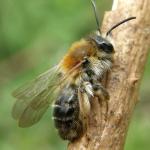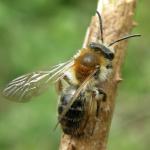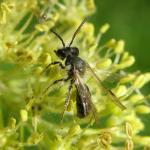Throughout much of Britain and Ireland, the range extending as far north as East Sutherland (Golspie) and including the Isle of Man. There are no records from the Channel Islands. A north and central European species occurring from northern Fennoscandia to Turkey and the central Urals.
This bee is not regarded as being scarce or threatened.
Woodland, heaths, moors and coastal dunes. Rarely abundant.
Univoltine; mid May to mid July, exceptionally early August.
The species is reported to nest solitarily (Kocourek, 1966; Dylewska, 1987; Westrich, 1989). However, R.C.L. Perkins (1919) found a small aggregation of about a dozen burrows placed close together.
In addition to the forage species listed above, the bee has also been reported to visit bilberry (Vaccinium sp.), hawthorn (Crataegus sp.), plum (Prunus sp.), water-dropwort (Oenanthe sp.), wood spurge (Euphorbia amygdaloides) and yellow pimpernel (Lysimachia nemorum).
Nomada panzeri Lepeletier is a probable cleptoparasite of this species (R.C.L.Perkins, 1919; Westrich, 1989).
2005




